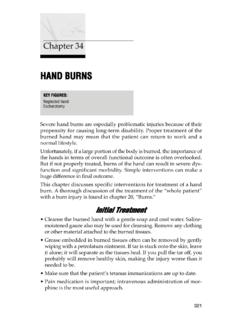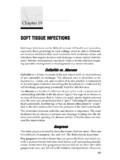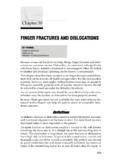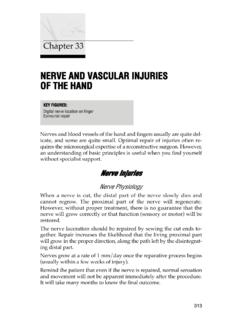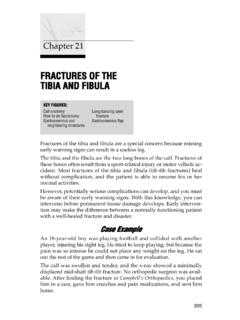Transcription of SUTURING: THE BASICS - Practical Plastic Surgery
1 SSUUTTUURRIINNGG:: TTHHEE BBAASSIICCSSS uturing is the joining of tissues with needle and thread, so that thetissues bind together and heal. The thread is actually specializedsuture material. Health care providers frequently encounter wounds in need of sutur-ing, and it is important to become proficient. You can practice your su-turing skills on pigs feet, available at a butcher shop. This chapter givesyou all the necessary information to perform basic suturing , including: Types of needles and suture material Selection of material for various wounds and situations Techniques Information about the proper use of local anesthetics for pain controlwhile placing sutures is discussed in chapter NNeeeeddlleessThere are two broad classifications of needles: curved and straight. Astraight needle can be used without instruments. A curved needle mustbe handled with forceps and a needle holder. Although hand sewing with a straight needle does not require forceps,the technique is cumbersome and entails a much higher risk of ac-cidentally sticking yourself.
2 Hence, suturing with a straight needle is1 Chapter 1 KKEEYY FFIIGGUURREESS::Curved needles: tapered and cuttingSimple suturesEversion of skin edgesContinuous vs. interrupted closureInstruments: needle holderMattress suturesInstruments: forceps with teethBuried intradermal suturesInstruments: suture scissorsFigure-of-eight suturesHolding scissors and needle holderInstrument tieNeedle in the needle holderSkin stapler in positionHolding the forcepsStaple remover: clamp removing the stapleFace bites vs. body bitesAdhesive stripsNeedle entering tissues at 90 angle2 Practical Plastic Surgery for Nonsurgeonsuncommon and not recommended if curved needles are , forceps and needle holders are available, and a curvedneedle is used for suturing . There are two types of curved needles. Cutting cutting needle is used primarily for suturing theskin. It has a very sharp tip with sharp edges, which are needed to passthrough the skin. Since you will place primarily skin sutures, you gen-erally will use a cutting needles, or round-bodied needles, havea sharp tip with smooth edges and are less traumatic to the surround-ing tissues.
3 They are used primarily on the deeper, subcutaneous tis-sues, blood vessels, and intestinal anastomoses. A tapered needle is notgood for simple skin suturing because it is difficult to pass the taperedneedle through the SSiizzeessSutures come in various sizes. The bigger the suture material, usuallythe bigger the needle. The sizing of sutures is similar to the sizing ofneedles for injection: the bigger the number, the smaller the size of thesuture. Suture sizes range from 00 (very large, used to close the abdom-inal wall about the size of large fishing line) to 10-0 (very tiny, usedfor microvascular anastomoses as fine as a human hair). You gener-ally will use sizes in the middle range: 3-0 to is best to use small sutures on the face, such as 5-0 or 6-0. Smaller su-tures are associated with decreased scarring, which is a concern withfacial wounds. (See chapter 16, Facial Lacerations, for more specificdetails.) On areas where cosmetic concerns are less important, 3-0 or 4-0 sutures are best, because the larger size makes the technique easierand the thicker sutures are stronger.
4 The tendency is to use smaller su-tures on children because of their more delicate skin. Rarely do youneed anything larger than a 4-0 , Tapered needle used for suturing subcutaneous tissue, fascia, and otherdeep , Cutting needle used for suturing skin. Note the differencespecifically around the tip of each : The BASICS 3 SSuuttuurree MMaatteerriiaallMany different suture materials are available. The main classificationsare absorbable or nonabsorbable. A more subtle subclassification iswhether the suture material is braided or there is a dire emergency, neveruse regular thread for suturesbecause of the risk of SuturesNonabsorbable sutures remain in place until they are they are not dissolved by the body, they are less tissue-reactiveand therefore leave less scarring as long as they are removed in atimely fashion. They are best used on the skin. Absorbable SuturesAbsorbable sutures are dissolved by the body's tissues. The great ad-vantage is that the sutures do not need to be removed.
5 However, ab-sorbable sutures tend to leave a more pronounced scar when used asskin sutures. Absorbable sutures are primarily used under the skin,where they are well is sometimes difficult to get patients to return for suture removal. Ifthis is a concern, use an absorbable suture for skin closure. You shouldwarn the patient that absorbable sutures probably will result in a morenoticeable scar than nonabsorbable sutures with later removal. Because it is often difficult to remove stitches from children (because oftheir crying and difficulty in staying still), absorbable materials shouldbe used when suturing their SuturesBraided sutures are made up of several thin strands of the suture mate-rial twisted together. Braided sutures are easier to tie than nonbraidedsutures. However, braided sutures have little interstices in the suturematerial, which can be a place for bacteria to hide and grow, resultingin an increased risk of infection. Nonbraided SuturesNonbraided sutures are simply a monofilament, a single strand.
6 Theyare not made up of the little subunits found in a braided sutures are recommended for most skin closures, espe-cially wounds that may be at risk for Practical Plastic Surgery for NonsurgeonsTTaabbllee ooff tthhee MMoosstt CCoommmmoonnllyy UUsseedd SSuuttuurree MMaatteerriiaallssA = absorbable, N = nonabsorbable, 0 = no tissue reaction, +++ = highly TTeecchhnniiqquueessWhen suturing the edges of a wound together, it is important to evertthe skin edges that is, to get the underlying dermis from both sides ofthe wound to touch. For the wound to heal, the dermal elements mustmeet and heal together. If the edges are inverted (the epidermis turnsin and touches the epidermis of the other side), the wound will notheal as quickly or as well as you would like. The suture technique thatyou choose is important to achieve optimal wound oorr NNBB rraaiiddeeddBBrraaiiddeeddSSttrreennggtt hhPPrriimmaarryy IInnddiiccaattiioonnChromic+++AXLasts 3 4 Facial wounds,catgutwks atlip/intraoralmostmucosa, chil-dren s woundsNylon+NXLoses 20% Skin suturesper yearPolydioxa-+AXLasts 4 6 Intradermal su-none (PDS)moturesPolyglycolic acid ++AXLasts about Intradermal su-(Dexon)1 motures, suturesfor fascia,muscle, muco-sa, or subcu-taneous tissueProlene0 NXLasts a long Skin suturestimeSilk+++NXLosesVery clean skinstrengthwounds, es-withinpecially on1 yreyelidsSutures should be placed so that the skin edges are everted to ensure that thedermis is technique is important for proper healing.
7 (From McCarthyJG (ed): Plastic Surgery . Philadelphia, Saunders, 1990, with permission.) suturing : The BASICS 5 Instruments NeededNeedle holder:used to grab onto the suture needleForceps:used to hold the tissues gently and to grab the needleSuture scissors:used to cut the stitch from the rest of the suture materialHow to Hold the InstrumentsWhenever you use sharp instruments, you face the risk of accidentallysticking yourself. Needlesticks are especially hazardous because of therisk of serious infection (hepatitis, human immunodeficiency virus). Toprevent needlesticks, get in the habit of using the instruments handle the suture needle with your your thumb and ring finger in the holes. It is best tocut with the tips of the scissors so that you do not accidentally injureany surrounding structures or tissue (which may happen if you cutwith the center part of the scissors).Needle your thumb and ring finger in the holes. Whenusing the needle holder, be sure to grab the needle until you hear theclasp engage, ensuring that the needle is securely held.
8 You grab theneedle at its half-way point, with the tip pointing upward. Try not tograb the tip; it will become blunt if grabbed by the needle holder. Thenit will be difficult to pass the tip through the ,Needle holder. Center,Forceps with teeth. Right,Suture scissors.(Courtesy of Padgett Instruments, Inc.)6 Practical Plastic Surgery for the forceps like a writing utensil. The forceps is usedto support the skin edges when you place the sutures. Be careful not tograb the skin too hard, or you will leave marks that can lead to scar-ring. Ideally, you should grab the dermis or subcutaneous tissue notthe skin with the forceps, but this technique takes practice. For sutur-ing skin, try to use forceps with teeth, which are little pointed edges atthe end of the needle holder and scissors are handled similarly. For maximal control,place the tips of your thumb and ring finger into the rings of the thumb does most of the work to open and close the needle should be held inthe jaws of the needle holder atits midpoint (where the curve ofthe needle is relatively flat).
9 This technique prevents youfrom bending the needle as itpasses through the : The BASICS 7 Placing the SuturesFor most areas of the body, except the face (see chapter 16, FacialLacerations ), the sutures should be placed in the skin 3 4 mm fromthe wound edge and 5 10 mm the forceps as you would hold a writing placed on the face should be approx-imately 2 3 mm from the skin edge and 3 5mm apart. Sutures placed elsewhere on thebody should be approximately 3 4 mm fromthe skin edge and 5 10 mm Practical Plastic Surgery for NonsurgeonsStart on the side of the wound opposite and farthest from you toensure that you are always sewing toward yourself. By sewing towardyourself, the suturing process is made easier from a not drive yourself crazy by placing too many technique is the easiest to perform. It is used formost skin Start from the outside of the skin, go through the epidermis intothe subcutaneous tissue from one side, then enter the subcuta-neous tissue on the opposite side, and come out the To evert the edges, the needle tip should enter at a 90 angle tothe skin.
10 Then turn your wrist to get the needle through You can use simple sutures for a continuous or interrupted needle tip should enter the tissues perpendicular to the skin. Once theneedle tip has penetrated through the top layers of the skin, twist your wristso that the needle passes through the subcutaneous tissue and thencomes out into the wound. This technique helps to ensure that skin edgeswill : The BASICS 9 Interrupted or Continuous ClosureInterrupted Sutures Interrupted sutures are individually placed and tied. They are the technique of choice if you are worried about the cleanli-ness of the wound. If the wound looks like it is becoming infected, a few sutures can beremoved easily without disrupting the entire closure. Interrupted sutures can be used in all areas but may take longer toplace than a continuous Closure Place the sutures again and again without tying each individualsuture. If the wound is very clean and it is easy to bring the edges together, acontinuous closure is adequate and quicker to perform.
